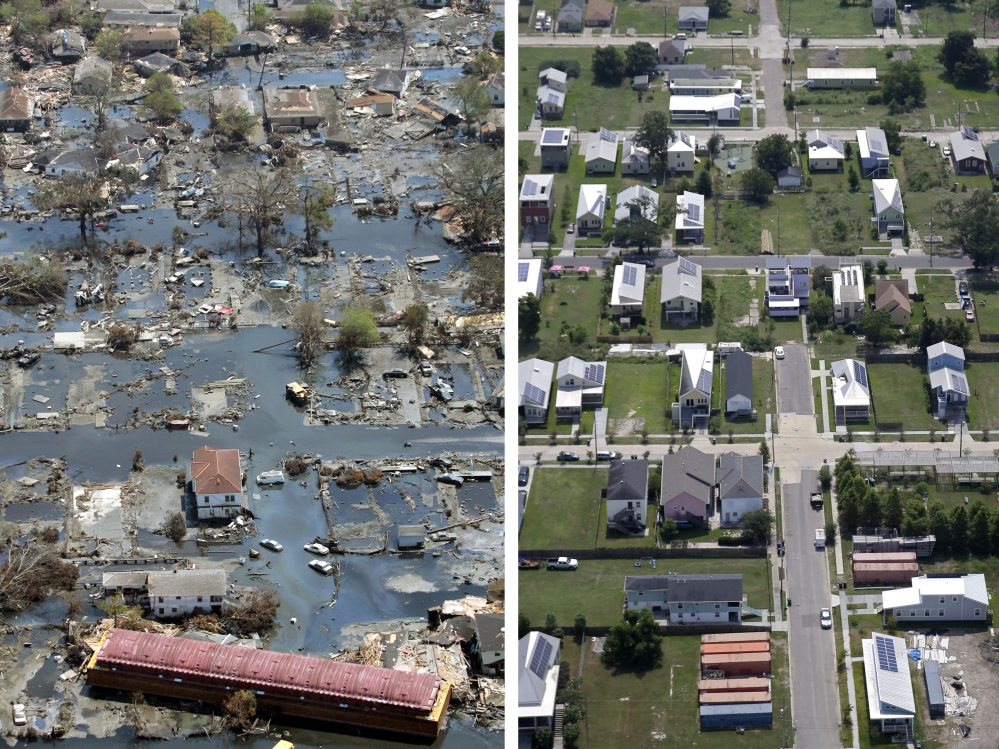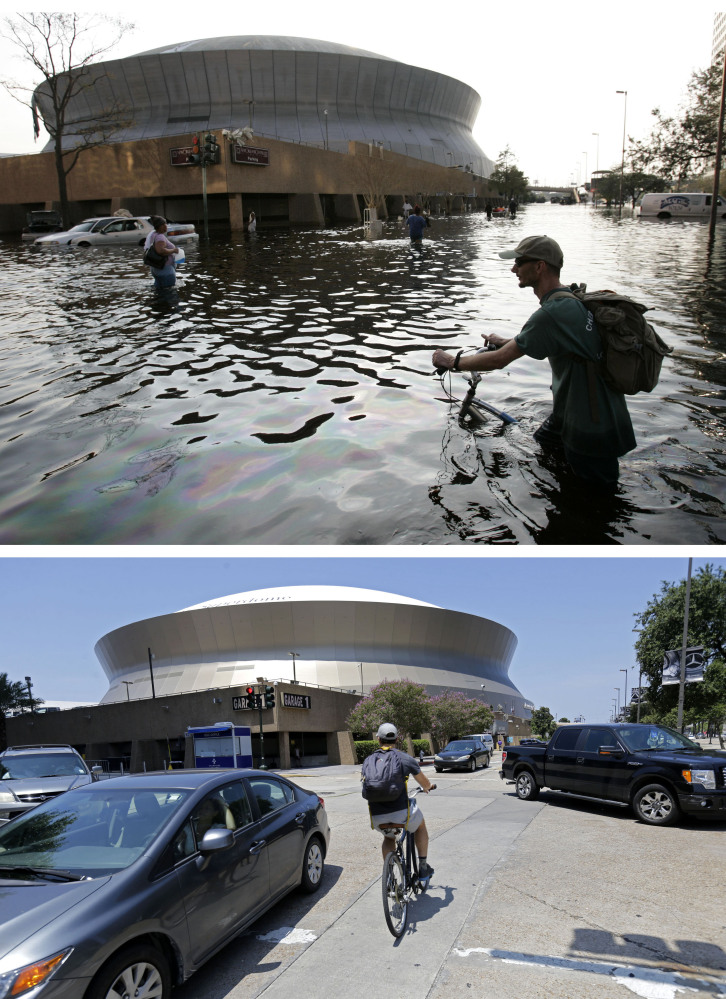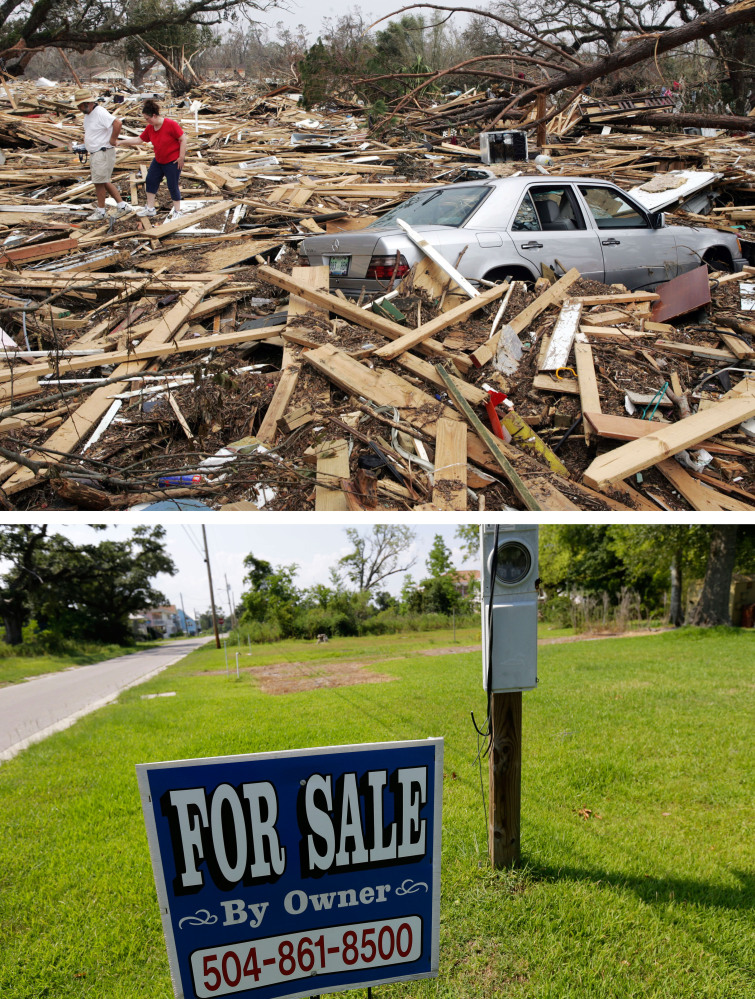NEW ORLEANS — As the church bells rang marking the decade since Hurricane Katrina struck the Gulf Coast, the 80-year-old woman leaning against her rusting Oldsmobile wept softly into a tissue.
“I feel guilty,” said Eloise Allen, whose house was damaged but inhabitable after the storm. “I didn’t go through what all the other people did.”
Saturday was a day to remember what “all the other people” went through. Those who were lifted from rooftops by helicopters, those who came home to find only concrete steps as evidence of where their house used to be, those whose bodies were never claimed after the storm.
But the mourning Saturday was balanced by a celebration of how far the region has come since Hurricane Katrina.
The storm, one of the country’s deadliest and most costly natural disasters, killed more than 1,800 people and caused $151 billion in damage. The dead were not far from anyone’s thoughts Saturday, from Mississippi where church bells rang out to mark when the storm made landfall to a commemoration at the New Orleans memorial containing bodies of people never claimed or never identified.
Mayor Mitch Landrieu spoke of the dark days after the monstrous storm and how the city’s residents leaned on each other for support.
“We saved each other,” the mayor said. “New Orleans will be unbowed and unbroken.”
In Biloxi, Mississippi, clergy and community leaders gathered at a newly built Minor League Baseball park for a memorial to Katrina’s victims; later that evening, the park was to host a concert celebrating the recovery.
A SHOWCASE OF REBUILDING
During a prayer service at a seaside park in Gulfport, former Mississippi Gov. Haley Barbour praised volunteers who worked on the Katrina recovery. He said more than 954,000 volunteers came from around the country to Mississippi in the first five years after the storm, and many were motivated by faith.
“They thought it was God’s command to try to help people in need,” Barbour said.
Katrina’s force caused a massive storm surge that scoured the Mississippi coast, pushed boats far inland and wiped houses off the map.
Glitzy casinos and condominium towers have been rebuilt. But overgrown lots and empty slabs speak to the slow recovery in some communities.
In New Orleans, wide-scale failures of the levee system on Aug. 29, 2005, left 80 percent of the city under water.
New Orleans has framed the 10th anniversary as a showcase designed to demonstrate to the world how far a city that some questioned rebuilding has come. In the week leading up to the actual anniversary, the city has held lectures, given tours of the levee improvements and released a resiliency plan.
Many parts of the iconic city have rebounded phenomenally while many residents – particularly in the black community – still struggle.
In New Orleans’ Lower 9th Ward, residents and community activists gathered Saturday at the levee where Katrina’s storm waters broke through and submerged the neighborhood.
Once a bastion of black home ownership, it still hasn’t regained anywhere near its pre-Katrina population. But a day of events illustrated how attached the residents who have returned are to their community.
After the speeches were done, a parade snaked through the neighborhood while music played from boom boxes and people sold water from ice chests under the hot sun.
Clarence Davis’ family home was four blocks from the levee. He evacuated before Katrina and eventually returned to the region, but now lives in the suburbs. He came back Saturday just to find old faces from the neighborhood, but he couldn’t bring himself to look at the vacant lot where his house used to be.
“The family home is what kept us together and it’s gone,” he said. His family is scattered now in Houston, Atlanta and Louisiana, as are many of his neighbors.
HELP APPRECIATED, STILL VITAL
Wilmington Sims watched the parade from his front porch. He helped build the house before Katrina, then had to redo the work after flooding from the levee break damaged the first floor.
He said the outpouring of support was “uplifting,” but many people still need help and the Lower 9th Ward needs economic development.
Former President Bill Clinton was scheduled to headline a free concert/prayer service/celebration Saturday night at Smoothie King Center in New Orleans, alongside award-winning journalist Soledad O’Brien and performances by the city’s “Rebirth Brass Band” and Big Chief Monk Boudreaux and the Wild Magnolias.
Neighborhoods across New Orleans held local events to commemorate the storm, and thousands of volunteers spread out across the city in a day of community activism.
As the anniversary came to a close and the region looks to the future, Maggie Carroll, who heads the Broadmoor Improvement Association in New Orleans, said there’s a “real challenge” to make sure that the spirit that drove so much of the recovery post-Katrina continues on.
“We need to fight the complacency. Our neighborhood still has problems, just like New Orleans has problems,” she said.
Send questions/comments to the editors.





Success. Please wait for the page to reload. If the page does not reload within 5 seconds, please refresh the page.
Enter your email and password to access comments.
Hi, to comment on stories you must . This profile is in addition to your subscription and website login.
Already have a commenting profile? .
Invalid username/password.
Please check your email to confirm and complete your registration.
Only subscribers are eligible to post comments. Please subscribe or login first for digital access. Here’s why.
Use the form below to reset your password. When you've submitted your account email, we will send an email with a reset code.